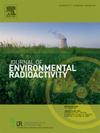温度对红土氡释放特性的影响。
IF 1.9
3区 环境科学与生态学
Q3 ENVIRONMENTAL SCIENCES
引用次数: 0
摘要
用烧制的红粘土制作的砖瓦在日常建筑活动中被广泛使用。然而,红土本身含有氡气,这种放射性物质可能会危害人类健康。因此,研究高温处理后红土的氡排放模式具有重要意义。本研究通过氮吸附法研究了高温处理后红土的孔隙结构,并分析了氡释放模式。研究结果表明,红粘土的氡释放率最初随温度升高而升高,然后随温度升高而降低,在 200 °C 时达到峰值,为 0.0127 Bq/(m2 s)。孔隙结构对氡的释放有很大影响,连通性和微孔体积与氡的释放率呈线性相关,相关系数分别为 0.96 和 0.78。这项研究为了解红粘土结构中的氡辐射提供了宝贵的见解。本文章由计算机程序翻译,如有差异,请以英文原文为准。
Effect of temperature on the radon release characteristics of red clay
Bricks and tiles crafted from fired red clay are extensively utilized in everyday construction activities. However, red clay inherently contains radon gas, a radioactive substance that could potentially endanger human health. Hence, investigating the radon emission patterns of red clay post high-temperature treatment holds significant importance. This study examines the pore structure of red clay following high-temperature treatment through nitrogen adsorption and analyzes the radon release patterns. Findings reveal that the radon release rate from red clay initially rises, then declines with increasing temperature, peaking at 200 °C, registering at 0.0127 Bq/(m2 s). The pore structure significantly influences radon exhalation, with connectivity and micropore volume demonstrating linear correlations with radon exhalation rate, with correlation coefficients of 0.96 and 0.78, respectively. This research offers valuable insights into radon radiation in structures made of red clay.
求助全文
通过发布文献求助,成功后即可免费获取论文全文。
去求助
来源期刊

Journal of environmental radioactivity
环境科学-环境科学
CiteScore
4.70
自引率
13.00%
发文量
209
审稿时长
73 days
期刊介绍:
The Journal of Environmental Radioactivity provides a coherent international forum for publication of original research or review papers on any aspect of the occurrence of radioactivity in natural systems.
Relevant subject areas range from applications of environmental radionuclides as mechanistic or timescale tracers of natural processes to assessments of the radioecological or radiological effects of ambient radioactivity. Papers deal with naturally occurring nuclides or with those created and released by man through nuclear weapons manufacture and testing, energy production, fuel-cycle technology, etc. Reports on radioactivity in the oceans, sediments, rivers, lakes, groundwaters, soils, atmosphere and all divisions of the biosphere are welcomed, but these should not simply be of a monitoring nature unless the data are particularly innovative.
 求助内容:
求助内容: 应助结果提醒方式:
应助结果提醒方式:


